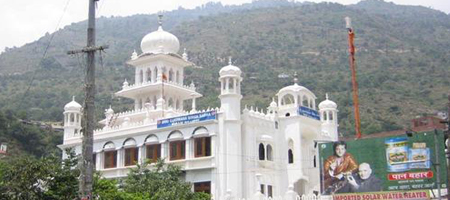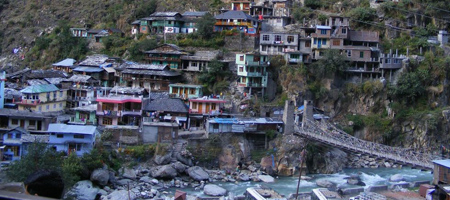As per the history of Kullu District, references of its origin could be traced back Ramayana and Mahabharata. The valley has witnessed a number of events and incidents believed to be associated with it during Ramayana and Mahabharata period. It is said that Pandavas it is said, visited this valley several times. According to one legend, Arjuna, under the advice of Rishi Vyas, practiced austerities in a cave called Arjun Gupha in the mountain of Inderkila (now called Deo Tiba) in order to get the powerful Pasupata Astra from Indra.
Places of Interest

Manali
Manali is situated at an altitude of 1,829 m in Himachal Pradesh. It is the main tourist destination of the Kullu Valley. Suggested clothing – heavy/light woolens in winter & summer. It receives an annual rainfall of 1,780 mm. In summer Manali is packed with Pahari speaking Kullus, Lahaulis, Nepali laborers, Tibetan refugees and foreign and Indian tourists. Apple growing has been the mainstay of the local economy. Manali is the center of a flourished orchard industry. A host of small shops, restaurants and small hotels provide the necessities of daily life. Every year more hotels are opened in and around Manali.
Vashishta
There is an interesting story about Manali which goes to say that Manu, the great Hindu law-giver, after the great deluge, first stepped on to earth from the celestial boat at a place in this land. The particular spot where he established his abode was the present Manali which is regarded as the changed name of ‘Manu-Alaya’, the home of Manu. It was from here that the human race came into being after the deluge. A small temple dedicated to Manu still exists in Manali village.

Kothi
A quiet but picturesque spot. The Rest House overlooks the narrow valley and commands views of the mountains. Below Kothi, for more than a kilometer the river Beas flows through a deep gorge, almost a subterranean passage, 30 meters or more in depth, and the cliffs which flank both sides of the canyon are a favorite haunt for rock pigeons. The site of the bridge provides an interesting historical episode in the early annals of Kullu.

Solang Valley
A splendid valley between Manali and Kothi which offers views of the glaciers and snow-capped mountain peaks. The plateau is frequently used for holding camps by the trekking parties. Local legends hold that after the Lord failed to find the lifesaving herb, and carried the whole hill and enroute to Lanka, the Monkey God is said to have rested atop Jakhoo for awhile. ood skiing slopes of the Mountaineering Institute. Venue of annual winter carnival from February 10-14. Bus service up to Palchan village (10 km) and then by jeep or on foot.

Manali Sanctuary
A bridle path from the Manali log huts goes past the Dhoongri Temple and wanders into the dense deodar, kail, horse chestnut, walnut and maple forest which is a part of this sanctuary. Camping overnight in tents at Lambadug or Galiani Thatch is possible. Lush green alpine pastures and glaciers lie beyond Galiani Thatch. Musk deer, monal and brown bear are often spotted. For those who venture still further into the glacier zone in summer, there are herds of ibex.

Rohtang Pass
At an altitude of 4,112 meters on the highway to Keylong, the pass affords a wide-spread panorama of mountain scenery. In place of the pinnacled hills, sheltered valleys and cultivated tracts, the eye meets a range of precipitous cliffs, huge glaciers and piled Moraine, and deep ravines. Almost directly opposite is the well defined Sonepani glacier, slightly to the left are the twin peaks of the Geypang, jagged pyramids of rock, snow streaked and snow crowned. The Beas river rises near the crest of Rohtang from a block of Mica-Schist. The pass normally opens for traffic after mid-June and officially closes in November. To its left, 200 meters higher, is the little lake of Sarkund (Dashair) visited by a number of people, the general belief being that a bath in these waters effects a cure of all bodily ailments-real or imaginary. 10 km before Rohtang is the barren-landscape of Marhi which hums with activity during summer and autumn months because almost everyone stops here for refreshments.

Manikaran
One of the holy pilgrimage of the Sikh’s, popularly known for its hot water springs. Here you can view the tremendous boiling water where locals could be seen while preparing roties and boiling rice and other meals. According to a legend, Manikaran is also associated with Lord Shiva and his divine consort, Parvati, who lost and recovered her ear-ring here. Gurudwara of manikaran is one of the visiting spot.

Naggar
One the hill station near Kullu Valley, very famous for its scenic beauty. Many of the Bollywood movies are shot here. Great camping site for the people in group . The full moon parties and camps are often scheduled here. On the left bank of the Beas and about three hundred metres above the river, Naggar is delightfully situated on a wooded slope and commands an extensive view, especially of the north west of the valley. It is an excellent place for a longer stay. Naggar was the capital of the Kullu Rajas for about 1,400 years. There are a large number of famous temples in and around Naggar. Artist Nicholas Roerich’s art gallery is also worth a visit. Cars and jeeps can easily go up to the Naggar Castle which is now Himachal Tourism’s well furnished Hotel Castle.

Malana
Malana is an ancient village to the north-east of Kullu Valley. The village administration is democratic and is believed to be the oldest republic of the world. This solitary village in the Parvati valley is isolated from the rest of the world. The majestic passes of Chandrakhani and Deotibba shadow the village. It is situated on a remote plateau by the side of torrential Malana river at a height of 2650mtrs above the sea level. Unaffected by the modern civilisation, Malana has its own lifestyle and social structure. People are strict in following their customs. For an outsider, these customs are mysterious and amazing at the same time. Malana is also well known in world for its best Quality of Marijuana known Malana Cream.



